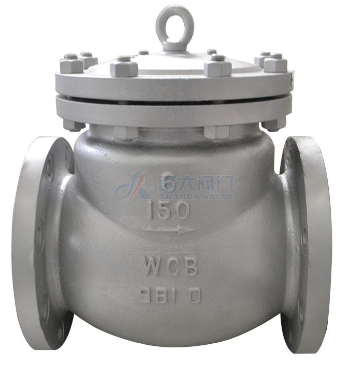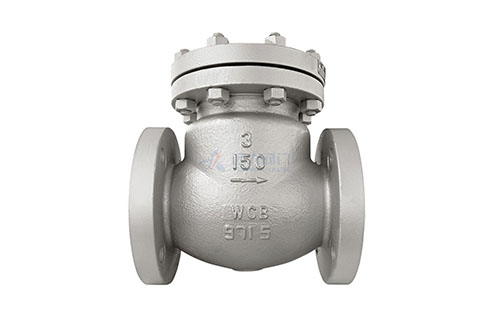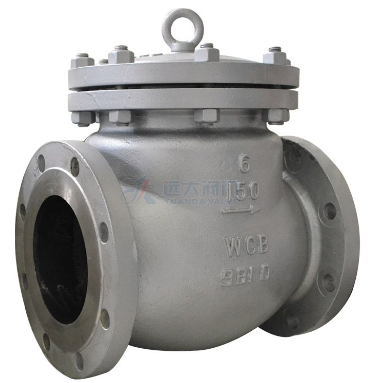What Are the Commonly Used Check Valves?
Contents:
ㆍUse of wafer check valve
ㆍThe main material of the wafer check valve
ㆍStandards and specifications of wafer check valve
ㆍThe structural characteristics of the wafer check valve
Check valve is also called one-way valve or check valve, its function is to prevent the medium in the pipeline from flowing back. The bottom valve of the pump to close the water is also a check valve.
The valve that opens or closes on its own by the flow and force of the medium to prevent the medium from flowing back is called a check valve. Check valves belong to the category of automatic valves, which are mainly used in pipelines where the medium flows in one direction, and only allow the medium to flow in one direction to prevent accidents.
Cast iron check valves are divided into three types: lift check valves, swing and lift check valves and butterfly check valves. Lift check valves can be divided into two types: vertical check valves and horizontal check valves. Swing check valves are divided into three types: single-leaf check valve, double-leaf check valve, and multi-leaf check valve. The butterfly check valve is a straight-through check valve. The above-mentioned check valves can be divided into three types in connection form: threaded check valve, flanged check valve, and welded check valve.

The installation of the check valve should pay attention to the following: 1. Do not make the check valve bear weight in the pipeline, and the large check valve should be independently supported so that it is not affected by the pressure generated by the piping system. 2. When installing, pay attention to the direction of medium flow should be consistent with the arrow direction of the valve body. 3. Lifting vertical flap check valve should be installed on the vertical pipeline. 4. Lifting the horizontal flap check valve should be installed on the horizontal pipeline.
Nominal pressure or pressure level of check valve: PN1.0-16.0MPa, ANSICLASS150-900, JIS10-20K Nominal diameter or caliber: DN15~900, NPS1/4~36 Connection method: flange, butt welding, thread, bearing Suitable temperature for plug welding: -196℃~540℃ Valve body material: WCB, ZG1Cr18Ni9Ti, ZG1Cr18Ni12Mo2Ti, CF8 (304), CF3 (304L), CF8M (316), CF3M (316L), Ti. Different materials are selected, and the check valve can be applied to various media such as water, steam, oil, nitric acid, acetic acid, oxidizing medium, urea, etc.
Use of wafer check valve
The check valve is installed in the pipeline system, and its main function is to prevent the medium from flowing back. The check valve is an automatic valve that depends on the pressure of the medium to open and close. The wafer check valve is suitable for various pipelines with nominal pressure PN1.0MPa~42.0MPa, Class150~25000; nominal diameter DN15~1200mm, NPS1/2~48; working temperature -196~540℃, used to prevent The medium flows back. By selecting different materials, it can be applied to a variety of media such as water, steam, oil, nitric acid, acetic acid, strong oxidizing media, and uric acid.
The main material of the wafer check valve
There are carbon steel, low-temperature steel, duplex steel (F51/F55), titanium alloy, aluminum bronze, INCONEL, SS304, SS304L, SS316, SS316L, chromium-molybdenum steel, Monel (400/500), 20# alloy, Hastelloy, and other metal materials. The use and structural characteristics of the wafer check valve

Standards and specifications of wafer check valve
1. Design and manufacturing: API594, API6D, JB/T8937, JB/T3595,
2. Structure length: API594, API6D, DIN3202, JB/T8937, ANSI/ASMEB16.10
3. Pressure and temperature rating: ANSIB16.34, DIN2401, GB/T9124, HG20604, HG20625, SH3406, JB/T74
4. Test and inspection: API598, JB/T9092, GB/T13927
5. Piping flange: JB/T74~90, GB/T9112-9124, HG20592~20635, SH3406, ANSI/ASMEB16.5, DIN2543-2548, GB/T13402, API605, ASMEB16.47
The structural characteristics of the wafer check valve
1. The structure length is short, and its structure length is only 1/4~1/8 of the traditional flange check valve
2. Small size and lightweight, its weight is only 1/4~1/20 of the traditional flange check valve
3. The valve flap closes quickly and the water hammer pressure is small
4. Both horizontal pipes and vertical pipes can be used, easy to install
5. Unobstructed flow path and low fluid resistance
6. Sensitive action and good sealing performance
7. The disc has a short stroke and a small closing impact
8. The overall structure is simple and compact, and the appearance is beautiful
9. Long service life and reliable performance
The role of the check valve in the pump water supply system is to prevent the impact of the high-pressure water backflow on the pump impeller. When the system is running for some reason, when the pump suddenly stops running, the pressure in the pump disappears, and the high-pressure water connected to the outlet of the pump will flow back to the pump in the reverse direction. When the pump outlet is equipped with a check valve, it will be closed immediately to prevent the high-pressure water from flowing back to the pump.
The cast steel check valve is an automatic valve whose main function is to prevent the backflow of the medium, prevent the pump and drive motor from reversing, and release the container medium. Check valves can also be used to supply pipelines for auxiliary systems whose pressure may rise above the system pressure. The main function of the check valve is to prevent the medium in the pipeline from flowing back. The opening and closing parts are opened or closed by themselves by the force of the flowing medium. The check valve is only used in the pipeline where the medium flows in one direction to prevent the medium from returning to prevent accidents. We are a check valve manufacturer. If you are interested in our products, please contact us now!
